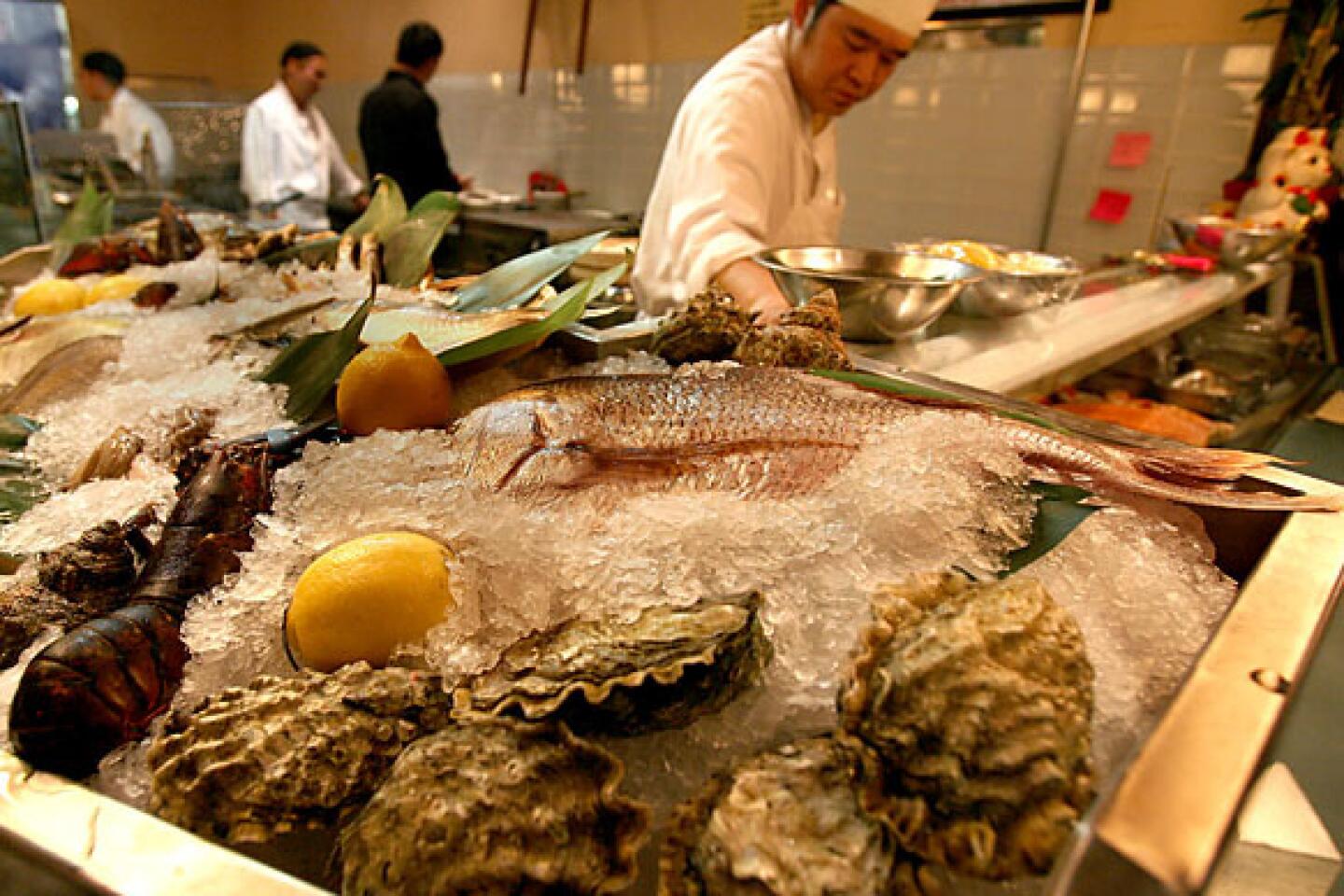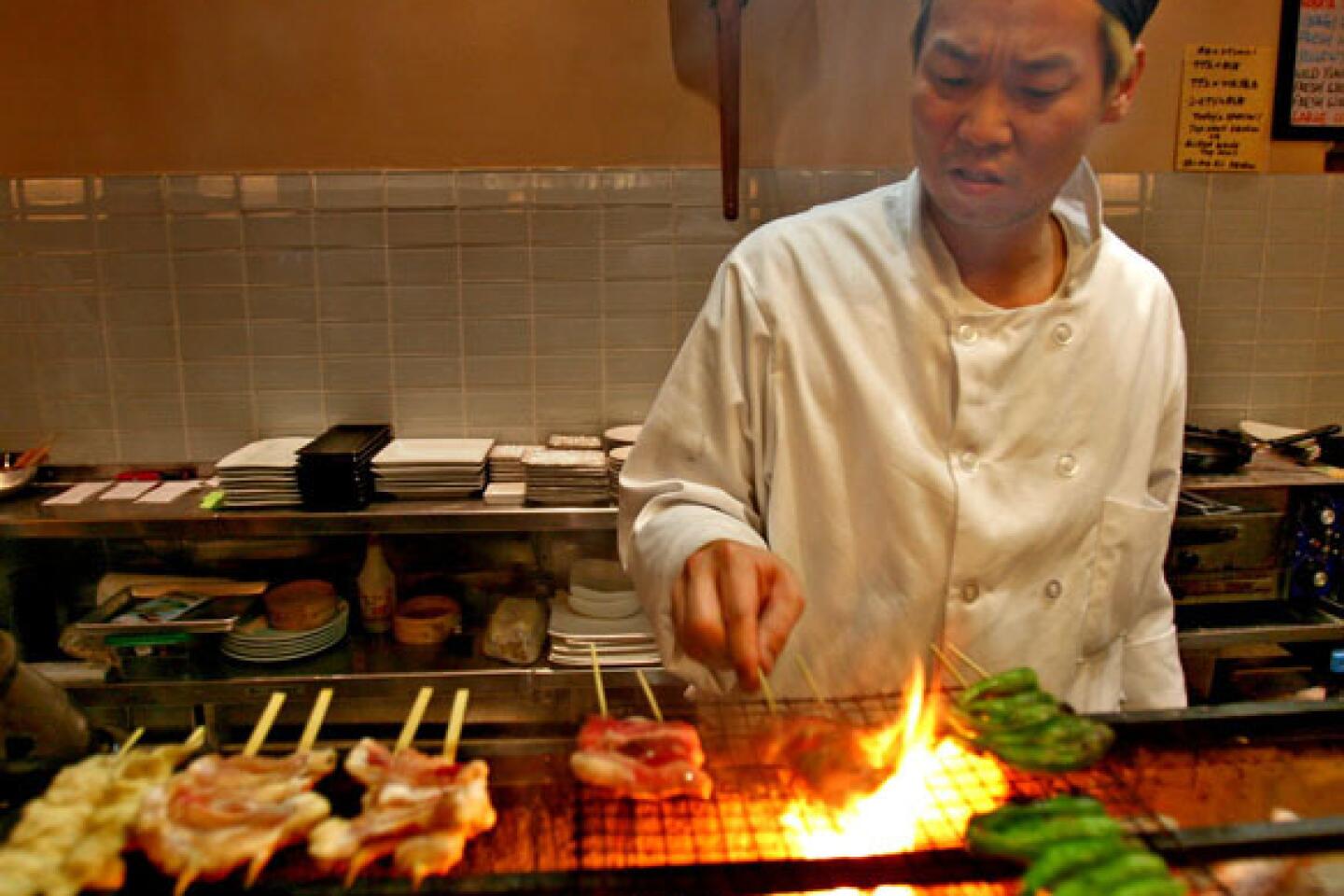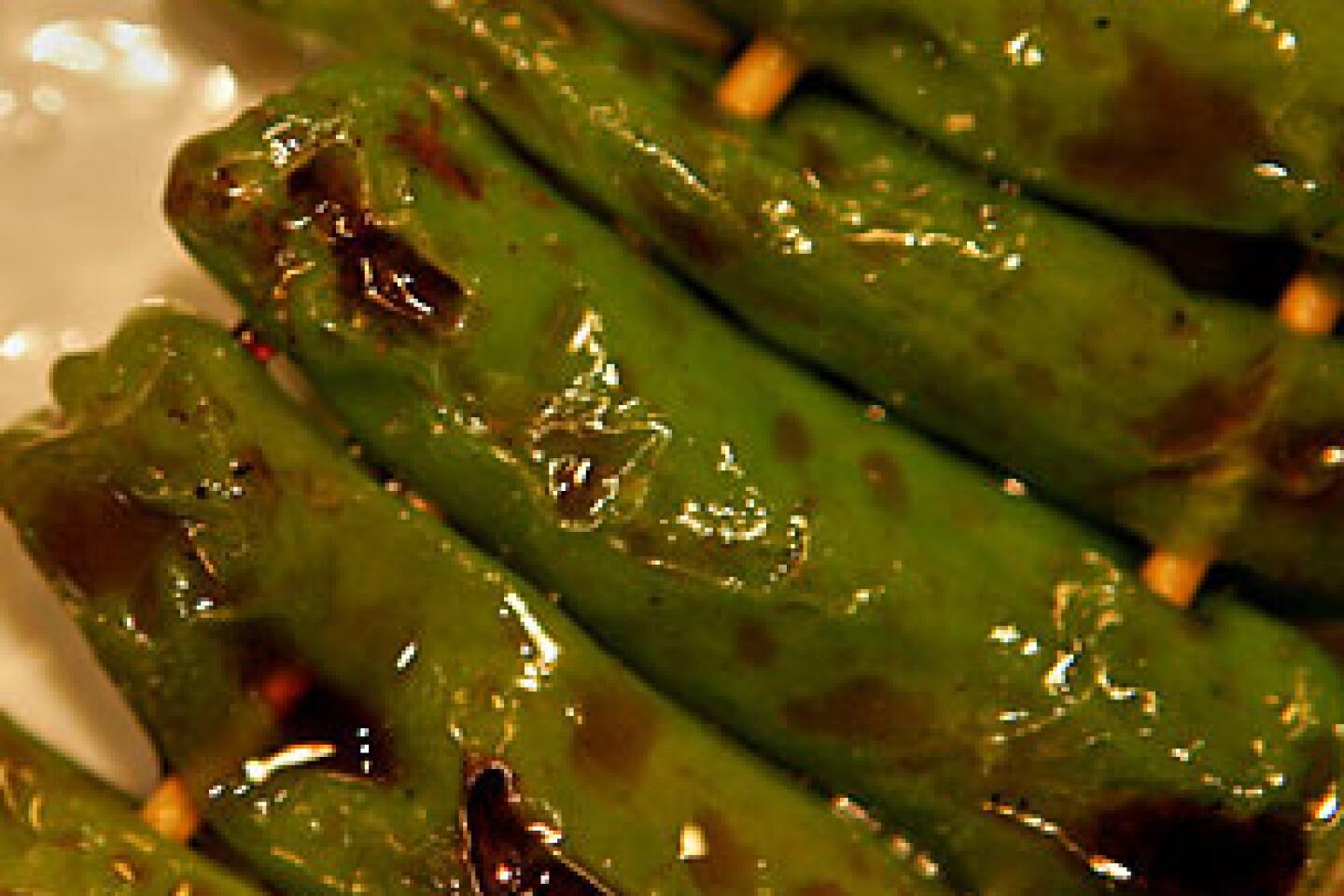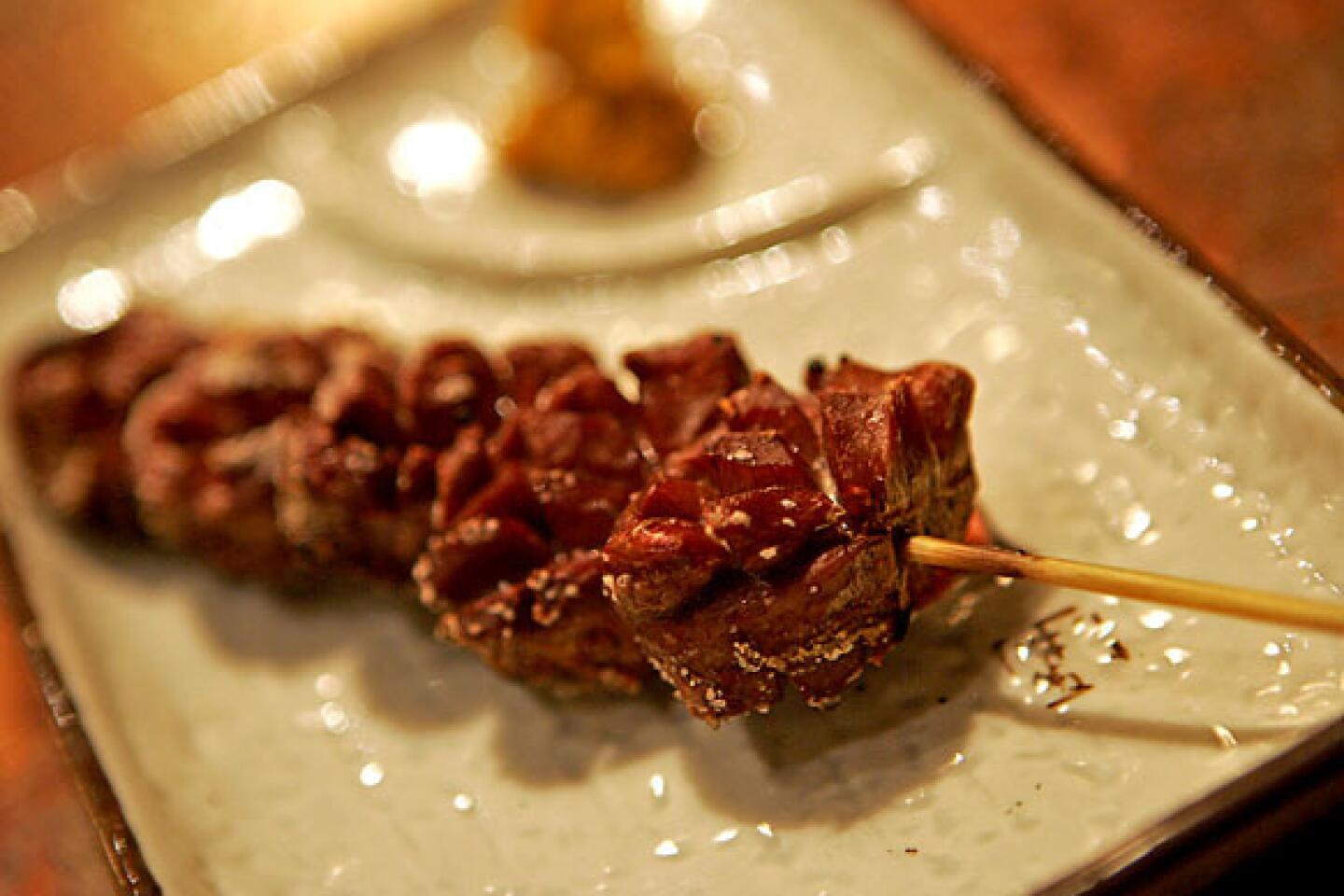Robata-Ya on Sawtelle in West L.A.
When we sit down at Robata-Ya, a casual new Japanese restaurant in West Los Angeles, our server hands us a long narrow paper listing the various items you can order. It’s something like a sushi menu, except this one is for robata and everything is grilled on skewers.
That night, I’m hankering for vegetables, and so, while I’m busy checking off okra, shishito peppers and shiitake mushrooms, one of my dining companions, Mr. Carnivore, is zeroing in on the chicken hearts. “What’s the difference between regular and special chicken hearts?” he asks. Inquiring minds want to know.
“The special hearts are bigger and chewier,” our server explains, struggling a little with her English. “They’re really good,” another waiter, more fluent, volunteers. “They have the aorta,” she adds, giggling. Uh-huh. “We’ll have the regular hearts,” Mr. Oh-So-Carnivorous says firmly, brooking no discussion.
We add some cold dishes and a few other appetizers to our order and our waiter gives a skip and a jump as she heads off to the kitchen, halfway concealed behind an indigo-patterned door curtain.
Robata-Ya occupies a high-ceilinged storefront on the same block of Sawtelle Boulevard as Orris, the casual French-Japanese place from Hideo Yamashiro (of Pasadena’s restaurant Shiro). There’s a shabu-shabu restaurant on the corner, a noodle house next door. I love the urban feeling of this stretch of Sawtelle. Pedestrians in a hurry crisscross the street. Someone shouts to a friend waiting for him on the corner. Groups of college students congregate in tea houses and boba parlors.
Robata-Ya isn’t as basic -- or as inexpensive -- as most of the other places. But the cooking is more polished and the physical space more curated. It isn’t as loud either, which means you can have a conversation with friends instead of yelling at them.
Robata-Ya, a small, relaxed place with 15 seats at the counter and half a dozen tables, is moderately priced by Westside standards. But for chef-owner Mako Tanaka, it’s something of a departure. The Japanese chef headed up the kitchen at Chinois on Main, now owns the namesake Mako in Beverly Hills and is a partner in the newly launched retro-Hawaiian called Luau, also in the general vicinity. But this is his most traditional restaurant.
The space has more design sense than, say, the bare bones Yakitori-ya down the street, with a giant paper lantern and banners printed with Japanese images floating from the high ceiling. The menu is much more embellished too, mixing izakaya-style dishes with robata and even adding some sushi and hand rolls for the toro-munching crowd. But why would I go to a robata restaurant to eat sushi?
Grilled skewers
It’s the grilled food that’s the real star here. The robata menu includes skewers of various chicken parts, including the skin and tail. Those hearts (the regular ones) are chewy and delicious, a little like Peru’s anticucho, though that is made with beef heart. But my particular favorite is the chicken gizzards, grilled so they’re a little crunchy on the outside, rosy within, with a distinctly gamy flavor. (If you like gizzards in your turkey dressing, you’ll like this.) Chicken meatballs are fluffy and tender, just a little spicy, which I like. Occasionally you’ll get a stick of chicken thigh or breast that’s a touch dried out, though.
The beef is American Wagyu (Kobe), only a few cuts, the best of which is the tongue, simply grilled to show off its complex taste. Pork belly stands out among the Kurobota pork skewers for its seductive texture and flavor.
If you want to really get into the skewer thing, order the 10-skewer omakase for $25; a smaller selection of six skewers, nothing too exotic, is $15. Both come with miso soup and a simple green salad.
I like that you can more or less just walk in and find a spot at the counter, which features a raw seafood display at one end. But to make sure you can get a table, you probably should reserve. (There are also a few more tables outside on the little sidewalk patio in front.)
Skewers threaded with vegetables, chicken and beef are piled up in a glass case at the counter. Behind is a hardwood charcoal (bincho) grill, long and skinny as a windowbox, and another the same size and shape next to it, fired with gas, with the typical flimsy wire grids used for grilling balanced on top.
Don’t forget to check out the specials that are chalked on the board above the bar. That’s where I found robata tuna served in a bowl with big slices of mountain potato and a garnish of shaved okra. The potato has that unique crunch and slight slipperiness that endears it to aficionados. Another special sounds tempting: wild tuna and scallop tataki. The quality of the fish is excellent, but, for me, the seafood is overdressed.
But, I’m sorry, I’m not ordering a highfalutin skewer of Kobe beef and foie gras. That’s Tanaka’s high-end dining experience coming through.
I did, however, go for Tanaka’s luxe version of chawan mushi, a savory egg custard served in a lidded cup and garnished with a few slices of black truffle amped up with truffle oil. The texture is silky and beautiful, but the custard would have had more character without the oil. Round out your order with a few cold dishes. Cucumber sunomono tossed with seaweed in a rice vinegar dressing is excellent. Chinese-style carpaccio of whitefish is delicious too, dressed in a hot sesame oil ponzu sauce that just warms it enough to bring out all the flavor.
Grilled cuttlefish, though, is unappealing and rubbery, so much so that we gobble up the boiled scallions in miso sauce underneath and end up leaving most of the cuttlefish. And you’re better off skipping the dull pork siu maias well. Oh, well. You win some and you lose some. With none of these dishes over $10 and most in the $3 to $5 range, you can let it go more easily.
One dish that’s always a hit is grilled rice cake with a salty-tart umeboshi plum at the heart. This goes a long way toward filling you up. Man does not live by skewer alone. There are also a couple of more substantial small-plates dishes, chief among them the chunk of braised black pork presented with a hard-boiled egg. It’s oddly minimalist -- and delicious. I also liked the moist, unctuous braised chicken wings sprinkled with green tea salt. And a bowl of tiny clams steamed in sake with iwanori seaweed is outstanding, a steal at $7.
Sake and soju
Tanaka hasn’t stinted on the sake and soju selection. He’s got more than 20 sakes, ranging from $30 to $70 for a full bottle, less for carafes, plus some wicked soju for those who like to wash down their robata with the fiery stuff.
For students and thrifty eaters who flock to Sawtelle Boulevard for ramen and other cheap eats, Robata-Ya may seem out of place. But Orris and restaurants such as 2117, the Franco-Japanese place that’s a favorite with wine buffs, have paved the way for Japanese dining at somewhat higher prices -- especially since they are still reasonable for the quality.
Still, you could stuff yourself with robata and the bill wouldn’t touch that of one of the better sushi restaurants. Robata-Ya is a great alternative whenever you want a quick bite in a more grown-up atmosphere. Anyone for chicken gizzards and a movie at the Nuart or Laemmle’s Royal?
RATING: * 1/2
LOCATION: 2004 Sawtelle Blvd. (at La Grange Avenue), Los Angeles, (310) 481-1418
AMBIENCE: Casual robata bar
PRICE: Salads and appetizers, $3 to $12; robata, $2 to $4.50; six skewers with salad and soup, $15; 10-skewer omakase, $25
BEST DISHES: Sunomono; steamed sake clams with seaweed; slow-braised chicken wings with green tea salt; braised black pork with boiled egg; robata of chicken neck, gizzard, heart, chicken sausage, pork belly and various vegetableso
DETAILS: Open 11:30 a.m. to 2:30 p.m. and 5 to 10 p.m. daily.
Rating is based on food, service and ambience, with price taken into account in relation to quality. ****: Outstanding on every level. ***: Excellent. **: Very good. *: Good. No star: Poor to satisfactory
More to Read
Sign up for The Wild
We’ll help you find the best places to hike, bike and run, as well as the perfect silent spots for meditation and yoga.
You may occasionally receive promotional content from the Los Angeles Times.

















